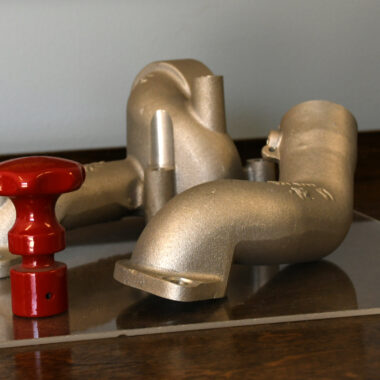Aluminum Casting Demystified: Trick Techniques for Success
Aluminum Casting Demystified: Trick Techniques for Success
Blog Article
Learning Light Weight Aluminum Casting: a Deep Dive Into the Numerous Methods Offered
From the standard approach of sand spreading to the facility processes of investment casting and pass away casting, each strategy provides unique difficulties and advantages. In this exploration of aluminum casting methods, we will certainly shed light on the complexities of each method, giving understandings that can change your technique to light weight aluminum casting.

Sand Casting Technique Review
The Sand Spreading method's convenience and widespread application make it a keystone in grasping aluminum spreading processes. This strategy involves creating a mold from a mix of sand and a binder, such as clay, to develop complex forms for casting molten aluminum. Sand casting is a prominent option due to its fairly reduced cost, simplicity of modification, and capacity to produce complex geometries with high precision.
The procedure begins with the production of a pattern, normally made of wood or metal, which is pressed right into the sand to produce a mold tooth cavity. Once the pattern is eliminated, the mold cavity is loaded with liquified aluminum, which solidifies to take the form of the pattern. After cooling and solidification, the sand mold and mildew is escaped, revealing the aluminum casting.
Sand casting is widely made use of in numerous sectors, consisting of automobile, aerospace, and production, due to its flexibility in producing both small and huge light weight aluminum parts (aluminum casting). Its versatility to complex styles and cost-effectiveness make it a preferred choice for several light weight aluminum casting applications
Irreversible Mold Spreading Refine Explained
Checking out the ins and outs of light weight aluminum casting, the Long-term Mold and mildew Casting process provides a polished approach for producing top notch parts with accuracy and efficiency. Unlike sand spreading, long-term mold and mildew spreading utilizes a multiple-use mold and mildew typically made of steel or iron to shape the molten light weight aluminum.
Permanent mold spreading can be categorized into two major types: gravity casting and low-pressure casting. Gravity casting entails pouring the molten steel right into the mold utilizing gravity, while low-pressure casting uses reduced stress to load the mold dental caries. Both approaches offer advantages in terms of minimizing porosity and enhancing mechanical properties.
Pass Away Casting: Benefits and Disadvantages
Mastering the details of die spreading includes comprehending its unique benefits and disadvantages in the realm of light weight aluminum part production. One key benefit is the high-speed production ability of die spreading, permitting for the mass production of complex shapes with tight tolerances.
The procedure is not as flexible when it comes to design adjustments contrasted to other casting methods like sand casting. In spite of these limitations, the advantages of die spreading frequently exceed the downsides, making it a favored selection for several aluminum spreading applications.
Investment Casting Advantages and applications
Structure on the advantages of die casting, investment spreading uses a functional approach for creating intricate aluminum parts with special benefits in different applications. Investment spreading, additionally called lost-wax spreading, masters developing complicated shapes that would be hard or difficult to accomplish through various other methods. This method is widely made use of in industries such as aerospace, vehicle, and jewelry production.
One of the crucial advantages of financial investment spreading is its capacity to generate near-net form parts, reducing the requirement for extra machining and minimizing material waste. This causes expense savings and faster production times compared to typical machining processes. Additionally, investment casting enables the manufacturing of get rid of exceptional surface area coatings and limited tolerances.
In the aerospace sector, investment spreading is favored for its ability to generate light-weight yet solid components essential Web Site for aircraft efficiency. The automobile sector gain from investment spreading for producing parts with high dimensional accuracy and complex layouts. Overall, financial investment spreading supplies a cost-effective and accurate service for producing detailed aluminum components across numerous markets.

Lost Foam Spreading: Just How It Works
Lost foam casting, likewise referred to as evaporative-pattern casting, is an approach for creating elaborate metal parts by using foam patterns that vaporize throughout the casting procedure. This strategy starts with a foam pattern of the preferred component being positioned right into unbonded sand. The foam pattern is normally coated with a refractory material to improve the surface area finish of the last metal component. When molten steel is put right into the mold, the foam evaporates because of the warmth, leaving behind a cavity that is after that loaded by the steel.
Among the essential advantages of lost foam spreading is its capacity to produce complex forms with intricate information that may be challenging to accomplish with other casting methods. Additionally, the procedure can be economical as it gets rid of the demand for cores and enables the consolidation of multiple parts right into a solitary part. It needs cautious control of the procedure parameters to guarantee proper foam evaporation and metal circulation.
Final Thought
Finally, mastering light weight aluminum casting entails understanding and using numerous techniques such as sand casting, long-term mold casting, pass away spreading, financial investment casting, and lost foam spreading. Each method has its own benefits and applications in the production process. By familiarizing oneself with these various methods, producers can choose one of the most ideal spreading technique for their certain requirements and requirements, ultimately leading to successful and reliable manufacturing of aluminum components.
From the traditional technique of sand spreading to the complex processes of financial investment spreading view it now and die casting, each strategy presents special obstacles and advantages. In this expedition of light Visit Your URL weight aluminum spreading techniques, we will certainly drop light on the ins and outs of each technique, providing understandings that might transform your technique to aluminum spreading.

Report this page